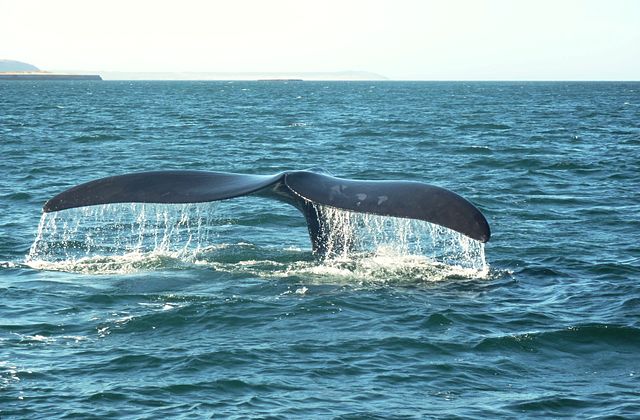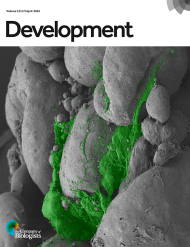Geometric analysis of airway trees shows that lung anatomy evolved to enable explosive ventilation and prevent barotrauma in cetaceans
Posted on: 26 November 2024 , updated on: 27 November 2024
Preprint posted on 18 October 2024
Geometry determines how deep whales dive? How airway metrics can protect whales from crushing hydrostatic pressure
Selected by Sarah Young-VeenstraCategories: animal behavior and cognition, evolutionary biology, physiology, zoology

Background
Whales, dolphins, and porpoises, known collectively as cetaceans, face a unique challenge of being obligate air breathers whilst spending their lives entirely underwater. Cetaceans’ aquatic existence is made possible by a host of biological specializations, including the biomechanical structure of their respiratory pathway.
As air breathers in water, cetaceans hold their breath for the majority of their lives. From breath to breath, cetaceans inhale, dive, resurface, exhale, repeat. Such a routine would decimate the human body. Indeed, if a breath-hold diver resurfaces from a dive deeper than 25 meters without exhaling through the ascent, the individual would experience pulmonary barotrauma – a condition brought on by a drastic pressure imbalance between the external environment, wherein pressure is rapidly decreasing, and the lung, wherein the pressure is increasing. As the gaseous pressure within the lung increases, the air can break through the pulmonary membrane, causing alveolar rupture and hemorrhage. Remarkably, despite enduring breath-hold ascents constantly, cetaceans avoid barotrauma, which is made possible by the ability to store oxygen in their blood and muscles instead of lungs, allowing them to compress their lungs at depth, and escape pulmonary pressure effects.
Cetaceans seal their blowholes while underwater, meaning they cannot exhale until reaching the surface. Once they reach the surface, they get a single breath to exchange large volumes of air in a very short time. The demand to immediately ventilate upon resurfacing from a dive presumably requires that air be stored within the respiratory system, such that it is ready to be rapidly exhaled. For reference, in humans, a single breath (inhale and exhale) takes approximately 3 seconds and exchanges 10-15% of air in the lungs. Some cetacean species can exhale and inhale within a fraction of a second and exchange 80-90% of their air in a ventilation strategy called “explosive ventilation”, which is common in shallow diving (up to 100m) cetaceans. Deep diving (below 100m) cetaceans tend to breath via a slower ventilatory strategy, wherein a breath takes 1-2 seconds to exchange ~80% of their air. Species who utilize the slower ventilation strategy are often referred to as “logging” species because they are known to periodically lie at the surface in a sleep-like state, breathing at a reduced rate. Whether “explosive” or “slow” ventilators, cetaceans’ efficient ventilation seems to mandate air storage within the airway, which exists in direct contrast to the demand to store air outside the lungs to avoid pulmonary barotrauma.
A possible solution is storing “old air” that is ready to be exhaled in the respiratory system, but within proximal bronchi that are resistant to pressure-induced compression (See visualization in Figure 2A in Ceiri et al. 2024, bioRxiv). In which case, large airways would likely be found in deep diving logging species. Conversely, wide airways may be required to facilitate rapid air movement with minimal resistance, which would suggest that wide airways should be found in shallow diving explosive ventilating species. Ceiri and his team at the University of British Columbia were interested in this functional dichotomy and investigated how airway geometry evolved in response to these competing biomechanical challenges.
Key Findings
To gain understanding as to how airway facilitates cetacean diving strategy with respect to the two major biomechanical pressures (air storage [1] amid hydrostatic pressure at depth and [2] being ready for immediate exhale upon resurfacing), the research team investigated how the airway diameter and airway tree branching angle differs between species who fall into various dive depth and ventilation speed categories:
- Shallow diving explosive ventilators: porpoises, dolphins
- Shallow diving intermediate ventilators: minke whale
- Moderate depth diving intermediate ventilators: orca whale
- Deep diving intermediate ventilators: beluga whale
- Deep diving logging ventilators: pilot whale, sperm whale, beaked whales
Additionally, the researchers investigated the airway geometry of a domestic pig to gauge how a terrestrial mammal compares to cetaceans.
Airway Diameter
Strahler diameter ratios describe the increase in tube diameter with each branch of the airway, moving from distal-most bronchioles to most proximal bronchi. The Strahler diameter ratios were highest in deep diving slow ventilating species, and diameters decreased as breathing speed got faster (See Figure 5 in Ceiri et al. 2024, bioRxiv).
This finding supports the authors’ “barotrauma hypothesis”, which expects that larger airways facilitate deep diving in cetaceans by providing compression-resistant air storage to protect the animal from barotrauma. Indeed, at the distal-most end of the airway, mammals, including cetaceans, have delicate bronchioles called acini that are responsible for gas exchange with the blood. The acini would be vulnerable to barotraumatic injury during dive resurfacing, but, in accordance with the barotrauma hypothesis, higher Strahler diameter ratios may protect the acini. As an individual dives to depth, and the pressure promotes organ compression, the acini compress and release their air into the adjacent airway; wider airways may provide enough extra space that the fragile acini can completely empty and, thereby, escape pulmonary barotrauma.
Furthermore, the authors pose that logging ventilation may be attributable to high Strahler diameter ratios. Counterintuitively, higher Strahler diameter ratios have been associated with increased flow resistance and, therefore, may necessitate logging ventilation to obtain enough oxygen. Lower Strahler diameter ratios facilitate higher rates of air flow and, potentially, more efficient ventilation. Therefore, the authors suggest that shallow diving cetaceans, who employ explosive ventilation strategies, may actually experience selection for lower Strahler diameter ratios – which would, further, align with the barotrauma hypothesis.
Airway Tree Branching Angle
The authors observed that the average angle of bronchiole branches tended to decrease with deeper routine dive depth and increase with speed of ventilation (See Figure 4 in Ceiri et al. 2024, bioRxiv). Based on this apparent association, the authors pose that acute branching of the airway may facilitate more powerful ventilation cycles as the angular structure allows more and faster gas flow between acini and major bronchi.
Conclusion
This study investigated how airway geometry is associated with diving behaviour in cetaceans and, ultimately, suggests that wide airways evolved as a means for coping with hydrostatic pressure during dives by storing air to protect against pulmonary barotrauma when resurfacing.
Why I chose this preprint
I was enthralled by how this study explores what, initially, appeared to be a striking dichotomy of demands in how whales cope with two competing biomechanical challenges. I am fascinated by the complexity of animals who live in challenging environments and how it seems that, as science advances, more questions arise. This study, not only found support for their hypothesis, but also found that the demands were not, in fact, dichotomous.
Questions for the Authors and Future Directions
- I think it was interesting to compare the cetacean airways to that of a pig! I’m curious as to why you chose a pig for comparison? And there was little mention of the results regarding the pig. I’m wondering what the major observed differences were between cetaceans and pig, and whether pig airways were more similar to shallow/ deep diving/ rapid ventilating/ logging ventilating cetaceans?
- I think it’s a fascinating association between airway branching angle and ventilation speed. I’m wondering if you might expand on how a more angular airway might facilitate explosive ventilation? Were the pig’s airway branches much less angular than the cetaceans’?
- Do you know whether there are differences in the breathing-musculature of rapid vs. logging ventilators? Could ventilation type be impacted by strength of exhale/ inhale (i.e., might explosive ventilators have stronger breathing muscles)?
- The ages of animals observed in your analysis ranged from neonate to adult. Do you expect age and development might have any bearing on the results?
doi: https://doi.org/10.1242/prelights.38999
Read preprintSign up to customise the site to your preferences and to receive alerts
Register hereAlso in the animal behavior and cognition category:
Responses to conflicting binocular stimuli in mouse primary visual cortex
Maitri Manjunath
Effects of transcranial photobiomodulation on peripheral biomarkers associated with oxidative stress and complex IV activity in the prefrontal cortex in rats subjected to chronic mild stress
Rickson Ribeiro, Marcus Oliveira
Psychedelics Align Brain Activity with Context
Loïk Holdrinet et al.
Also in the evolutionary biology category:
A high-coverage genome from a 200,000-year-old Denisovan
AND
A global map for introgressed structural variation and selection in humans
Siddharth Singh
Dissecting Gene Regulatory Networks Governing Human Cortical Cell Fate
Manuel Lessi
Beyond venomous fangs: Uloboridae spiders have lost their venom but not their toxicity
Daniel Fernando Reyes Enríquez, Marcus Oliveira
Also in the physiology category:
Imaging cellular activity simultaneously across all organs of a vertebrate reveals body-wide circuits
Muhammed Sinan Malik
Wide-ranging behavioral dysfunction in two mouse models of pathological human variants in the GRIK2 kainate receptor gene
Pushpinder Singh
Fibroblast growth factor 21 regulates neuromuscular junction innervation through HDAC4 in denervation-induced skeletal muscle atrophy
Jórdan Sampar
Also in the zoology category:
The cold tolerance of an adult winter-active stonefly: How Allocapnia pygmaea (Plecoptera: Capniidae) avoids freezing in Nova Scotian winters
Stefan Friedrich Wirth
Loss of a morph is associated with asymmetric character release in a radiation of woodland salamanders
Stefan Friedrich Wirth
Scaly-Tail Organ Enhances Static Stability during Pel’s Scaly-tailed Flying Squirrels’ Arboreal Locomotion
EMB EMB_Liv et al.
preLists in the animal behavior and cognition category:
Biologists @ 100 conference preList
This preList aims to capture all preprints being discussed at the Biologists @100 conference in Liverpool, UK, either as part of the poster sessions or the (flash/short/full-length) talks.
| List by | Reinier Prosee, Jonathan Townson |
9th International Symposium on the Biology of Vertebrate Sex Determination
This preList contains preprints discussed during the 9th International Symposium on the Biology of Vertebrate Sex Determination. This conference was held in Kona, Hawaii from April 17th to 21st 2023.
| List by | Martin Estermann |
Bats
A list of preprints dealing with the ecology, evolution and behavior of bats
| List by | Baheerathan Murugavel |
FENS 2020
A collection of preprints presented during the virtual meeting of the Federation of European Neuroscience Societies (FENS) in 2020
| List by | Ana Dorrego-Rivas |
Also in the evolutionary biology category:
November in preprints – DevBio & Stem cell biology
preLighters with expertise across developmental and stem cell biology have nominated a few developmental and stem cell biology (and related) preprints posted in November they’re excited about and explain in a single paragraph why. Concise preprint highlights, prepared by the preLighter community – a quick way to spot upcoming trends, new methods and fresh ideas.
| List by | Aline Grata et al. |
October in preprints – DevBio & Stem cell biology
Each month, preLighters with expertise across developmental and stem cell biology nominate a few recent developmental and stem cell biology (and related) preprints they’re excited about and explain in a single paragraph why. Short, snappy picks from working scientists — a quick way to spot fresh ideas, bold methods and papers worth reading in full. These preprints can all be found in the October preprint list published on the Node.
| List by | Deevitha Balasubramanian et al. |
October in preprints – Cell biology edition
Different preLighters, with expertise across cell biology, have worked together to create this preprint reading list for researchers with an interest in cell biology. This month, most picks fall under (1) Cell organelles and organisation, followed by (2) Mechanosignaling and mechanotransduction, (3) Cell cycle and division and (4) Cell migration
| List by | Matthew Davies et al. |
Biologists @ 100 conference preList
This preList aims to capture all preprints being discussed at the Biologists @100 conference in Liverpool, UK, either as part of the poster sessions or the (flash/short/full-length) talks.
| List by | Reinier Prosee, Jonathan Townson |
‘In preprints’ from Development 2022-2023
A list of the preprints featured in Development's 'In preprints' articles between 2022-2023
| List by | Alex Eve, Katherine Brown |
preLights peer support – preprints of interest
This is a preprint repository to organise the preprints and preLights covered through the 'preLights peer support' initiative.
| List by | preLights peer support |
EMBO | EMBL Symposium: The organism and its environment
This preList contains preprints discussed during the 'EMBO | EMBL Symposium: The organism and its environment', organised at EMBL Heidelberg, Germany (May 2023).
| List by | Girish Kale |
9th International Symposium on the Biology of Vertebrate Sex Determination
This preList contains preprints discussed during the 9th International Symposium on the Biology of Vertebrate Sex Determination. This conference was held in Kona, Hawaii from April 17th to 21st 2023.
| List by | Martin Estermann |
EMBL Synthetic Morphogenesis: From Gene Circuits to Tissue Architecture (2021)
A list of preprints mentioned at the #EESmorphoG virtual meeting in 2021.
| List by | Alex Eve |
Planar Cell Polarity – PCP
This preList contains preprints about the latest findings on Planar Cell Polarity (PCP) in various model organisms at the molecular, cellular and tissue levels.
| List by | Ana Dorrego-Rivas |
TAGC 2020
Preprints recently presented at the virtual Allied Genetics Conference, April 22-26, 2020. #TAGC20
| List by | Maiko Kitaoka et al. |
ECFG15 – Fungal biology
Preprints presented at 15th European Conference on Fungal Genetics 17-20 February 2020 Rome
| List by | Hiral Shah |
COVID-19 / SARS-CoV-2 preprints
List of important preprints dealing with the ongoing coronavirus outbreak. See http://covidpreprints.com for additional resources and timeline, and https://connect.biorxiv.org/relate/content/181 for full list of bioRxiv and medRxiv preprints on this topic
| List by | Dey Lab, Zhang-He Goh |
1
SDB 78th Annual Meeting 2019
A curation of the preprints presented at the SDB meeting in Boston, July 26-30 2019. The preList will be updated throughout the duration of the meeting.
| List by | Alex Eve |
Pattern formation during development
The aim of this preList is to integrate results about the mechanisms that govern patterning during development, from genes implicated in the processes to theoritical models of pattern formation in nature.
| List by | Alexa Sadier |
Also in the physiology category:
October in preprints – DevBio & Stem cell biology
Each month, preLighters with expertise across developmental and stem cell biology nominate a few recent developmental and stem cell biology (and related) preprints they’re excited about and explain in a single paragraph why. Short, snappy picks from working scientists — a quick way to spot fresh ideas, bold methods and papers worth reading in full. These preprints can all be found in the October preprint list published on the Node.
| List by | Deevitha Balasubramanian et al. |
Biologists @ 100 conference preList
This preList aims to capture all preprints being discussed at the Biologists @100 conference in Liverpool, UK, either as part of the poster sessions or the (flash/short/full-length) talks.
| List by | Reinier Prosee, Jonathan Townson |
Fibroblasts
The advances in fibroblast biology preList explores the recent discoveries and preprints of the fibroblast world. Get ready to immerse yourself with this list created for fibroblasts aficionados and lovers, and beyond. Here, my goal is to include preprints of fibroblast biology, heterogeneity, fate, extracellular matrix, behavior, topography, single-cell atlases, spatial transcriptomics, and their matrix!
| List by | Osvaldo Contreras |
FENS 2020
A collection of preprints presented during the virtual meeting of the Federation of European Neuroscience Societies (FENS) in 2020
| List by | Ana Dorrego-Rivas |
TAGC 2020
Preprints recently presented at the virtual Allied Genetics Conference, April 22-26, 2020. #TAGC20
| List by | Maiko Kitaoka et al. |
Autophagy
Preprints on autophagy and lysosomal degradation and its role in neurodegeneration and disease. Includes molecular mechanisms, upstream signalling and regulation as well as studies on pharmaceutical interventions to upregulate the process.
| List by | Sandra Malmgren Hill |
Cellular metabolism
A curated list of preprints related to cellular metabolism at Biorxiv by Pablo Ranea Robles from the Prelights community. Special interest on lipid metabolism, peroxisomes and mitochondria.
| List by | Pablo Ranea Robles |
Also in the zoology category:
Biologists @ 100 conference preList
This preList aims to capture all preprints being discussed at the Biologists @100 conference in Liverpool, UK, either as part of the poster sessions or the (flash/short/full-length) talks.
| List by | Reinier Prosee, Jonathan Townson |
Bats
A list of preprints dealing with the ecology, evolution and behavior of bats
| List by | Baheerathan Murugavel |











 (No Ratings Yet)
(No Ratings Yet)